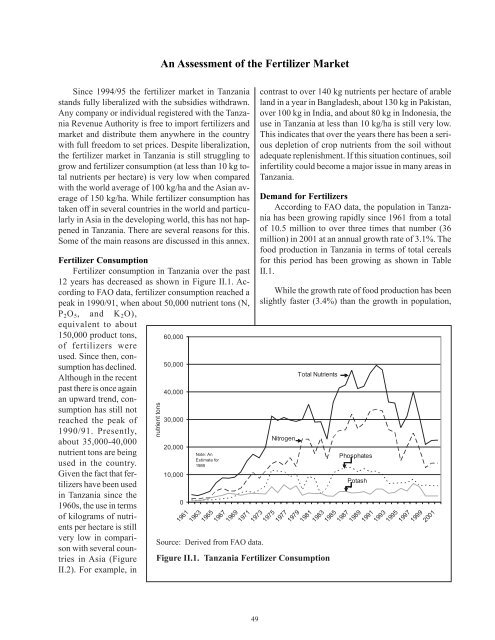An Action Plan for Developing Agricultural Input Markets in Tanzania
An Action Plan for Developing Agricultural Input Markets in Tanzania
An Action Plan for Developing Agricultural Input Markets in Tanzania
Create successful ePaper yourself
Turn your PDF publications into a flip-book with our unique Google optimized e-Paper software.
S<strong>in</strong>ce 1994/95 the fertilizer market <strong>in</strong> <strong>Tanzania</strong><br />
stands fully liberalized with the subsidies withdrawn.<br />
<strong>An</strong>y company or <strong>in</strong>dividual registered with the <strong>Tanzania</strong><br />
Revenue Authority is free to import fertilizers and<br />
market and distribute them anywhere <strong>in</strong> the country<br />
with full freedom to set prices. Despite liberalization,<br />
the fertilizer market <strong>in</strong> <strong>Tanzania</strong> is still struggl<strong>in</strong>g to<br />
grow and fertilizer consumption (at less than 10 kg total<br />
nutrients per hectare) is very low when compared<br />
with the world average of 100 kg/ha and the Asian average<br />
of 150 kg/ha. While fertilizer consumption has<br />
taken off <strong>in</strong> several countries <strong>in</strong> the world and particularly<br />
<strong>in</strong> Asia <strong>in</strong> the develop<strong>in</strong>g world, this has not happened<br />
<strong>in</strong> <strong>Tanzania</strong>. There are several reasons <strong>for</strong> this.<br />
Some of the ma<strong>in</strong> reasons are discussed <strong>in</strong> this annex.<br />
<strong>An</strong> Assessment of the Fertilizer Market<br />
Fertilizer Consumption<br />
Fertilizer consumption <strong>in</strong> <strong>Tanzania</strong> over the past<br />
12 years has decreased as shown <strong>in</strong> Figure II.1. Accord<strong>in</strong>g<br />
to FAO data, fertilizer consumption reached a<br />
peak <strong>in</strong> 1990/91, when about 50,000 nutrient tons (N,<br />
P2O5, and K2O),<br />
equivalent to about<br />
150,000 product tons,<br />
of fertilizers were<br />
used. S<strong>in</strong>ce then, consumption<br />
has decl<strong>in</strong>ed.<br />
Although <strong>in</strong> the recent<br />
past there is once aga<strong>in</strong><br />
an upward trend, consumption<br />
has still not<br />
reached the peak of<br />
1990/91. Presently,<br />
about 35,000-40,000<br />
nutrient tons are be<strong>in</strong>g<br />
used <strong>in</strong> the country.<br />
Given the fact that fertilizers<br />
have been used<br />
<strong>in</strong> <strong>Tanzania</strong> s<strong>in</strong>ce the<br />
1960s, the use <strong>in</strong> terms<br />
of kilograms of nutrients<br />
per hectare is still<br />
very low <strong>in</strong> comparison<br />
with several countries<br />
<strong>in</strong> Asia (Figure<br />
II.2). For example, <strong>in</strong><br />
Source: Derived from FAO data.<br />
Figure II.1. <strong>Tanzania</strong> Fertilizer Consumption<br />
49<br />
contrast to over 140 kg nutrients per hectare of arable<br />
land <strong>in</strong> a year <strong>in</strong> Bangladesh, about 130 kg <strong>in</strong> Pakistan,<br />
over 100 kg <strong>in</strong> India, and about 80 kg <strong>in</strong> Indonesia, the<br />
use <strong>in</strong> <strong>Tanzania</strong> at less than 10 kg/ha is still very low.<br />
This <strong>in</strong>dicates that over the years there has been a serious<br />
depletion of crop nutrients from the soil without<br />
adequate replenishment. If this situation cont<strong>in</strong>ues, soil<br />
<strong>in</strong>fertility could become a major issue <strong>in</strong> many areas <strong>in</strong><br />
<strong>Tanzania</strong>.<br />
Demand <strong>for</strong> Fertilizers<br />
Accord<strong>in</strong>g to FAO data, the population <strong>in</strong> <strong>Tanzania</strong><br />
has been grow<strong>in</strong>g rapidly s<strong>in</strong>ce 1961 from a total<br />
of 10.5 million to over three times that number (36<br />
million) <strong>in</strong> 2001 at an annual growth rate of 3.1%. The<br />
food production <strong>in</strong> <strong>Tanzania</strong> <strong>in</strong> terms of total cereals<br />
<strong>for</strong> this period has been grow<strong>in</strong>g as shown <strong>in</strong> Table<br />
II.1.<br />
While the growth rate of food production has been<br />
slightly faster (3.4%) than the growth <strong>in</strong> population,

















